Business Finance Report: Cash Flow, Budgeting and Analysis
VerifiedAdded on 2023/01/11
|13
|3375
|27
Report
AI Summary
This report provides a comprehensive analysis of business finance, focusing on cash flow management and budgeting strategies. The first part defines key financial terms such as profit, cash flow, working capital, receivables, payables, and inventory, illustrating their interrelationships and impact on financial results. The second part delves into the importance of budgeting, comparing traditional and alternative methods like rolling budgets and zero-based budgeting. The report analyzes the effects of working capital fluctuations on cash flows, providing recommendations for improving cash flow through effective inventory valuation, control over expenses, and timely payments. It also examines the application of these concepts in a case study, offering insights into practical financial management. The report offers a detailed examination of financial concepts and their practical application in business settings.
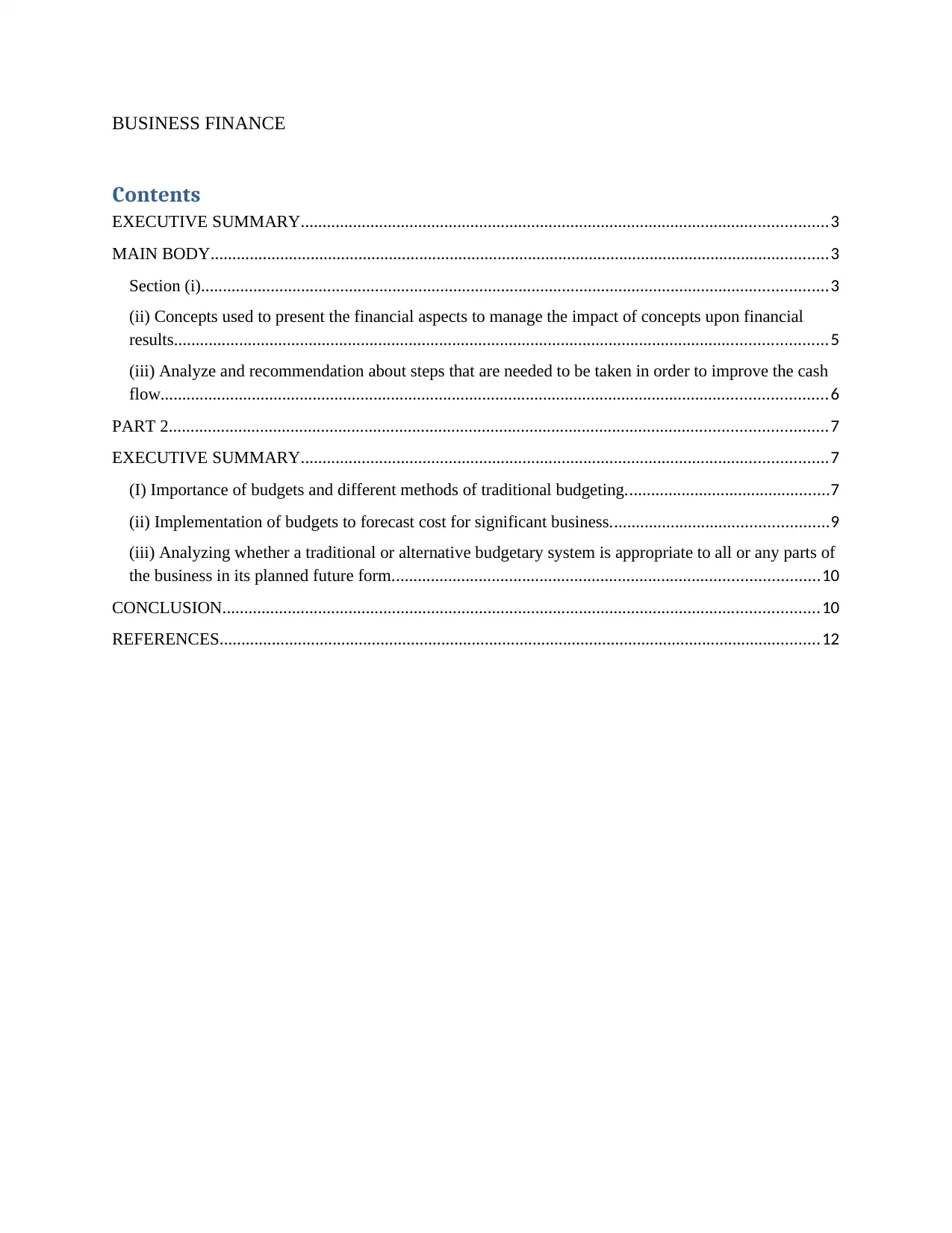
BUSINESS FINANCE
Contents
EXECUTIVE SUMMARY.........................................................................................................................3
MAIN BODY..............................................................................................................................................3
Section (i)................................................................................................................................................3
(ii) Concepts used to present the financial aspects to manage the impact of concepts upon financial
results......................................................................................................................................................5
(iii) Analyze and recommendation about steps that are needed to be taken in order to improve the cash
flow.........................................................................................................................................................6
PART 2.......................................................................................................................................................7
EXECUTIVE SUMMARY.........................................................................................................................7
(I) Importance of budgets and different methods of traditional budgeting...............................................7
(ii) Implementation of budgets to forecast cost for significant business..................................................9
(iii) Analyzing whether a traditional or alternative budgetary system is appropriate to all or any parts of
the business in its planned future form..................................................................................................10
CONCLUSION.........................................................................................................................................10
REFERENCES..........................................................................................................................................12
Contents
EXECUTIVE SUMMARY.........................................................................................................................3
MAIN BODY..............................................................................................................................................3
Section (i)................................................................................................................................................3
(ii) Concepts used to present the financial aspects to manage the impact of concepts upon financial
results......................................................................................................................................................5
(iii) Analyze and recommendation about steps that are needed to be taken in order to improve the cash
flow.........................................................................................................................................................6
PART 2.......................................................................................................................................................7
EXECUTIVE SUMMARY.........................................................................................................................7
(I) Importance of budgets and different methods of traditional budgeting...............................................7
(ii) Implementation of budgets to forecast cost for significant business..................................................9
(iii) Analyzing whether a traditional or alternative budgetary system is appropriate to all or any parts of
the business in its planned future form..................................................................................................10
CONCLUSION.........................................................................................................................................10
REFERENCES..........................................................................................................................................12
Paraphrase This Document
Need a fresh take? Get an instant paraphrase of this document with our AI Paraphraser

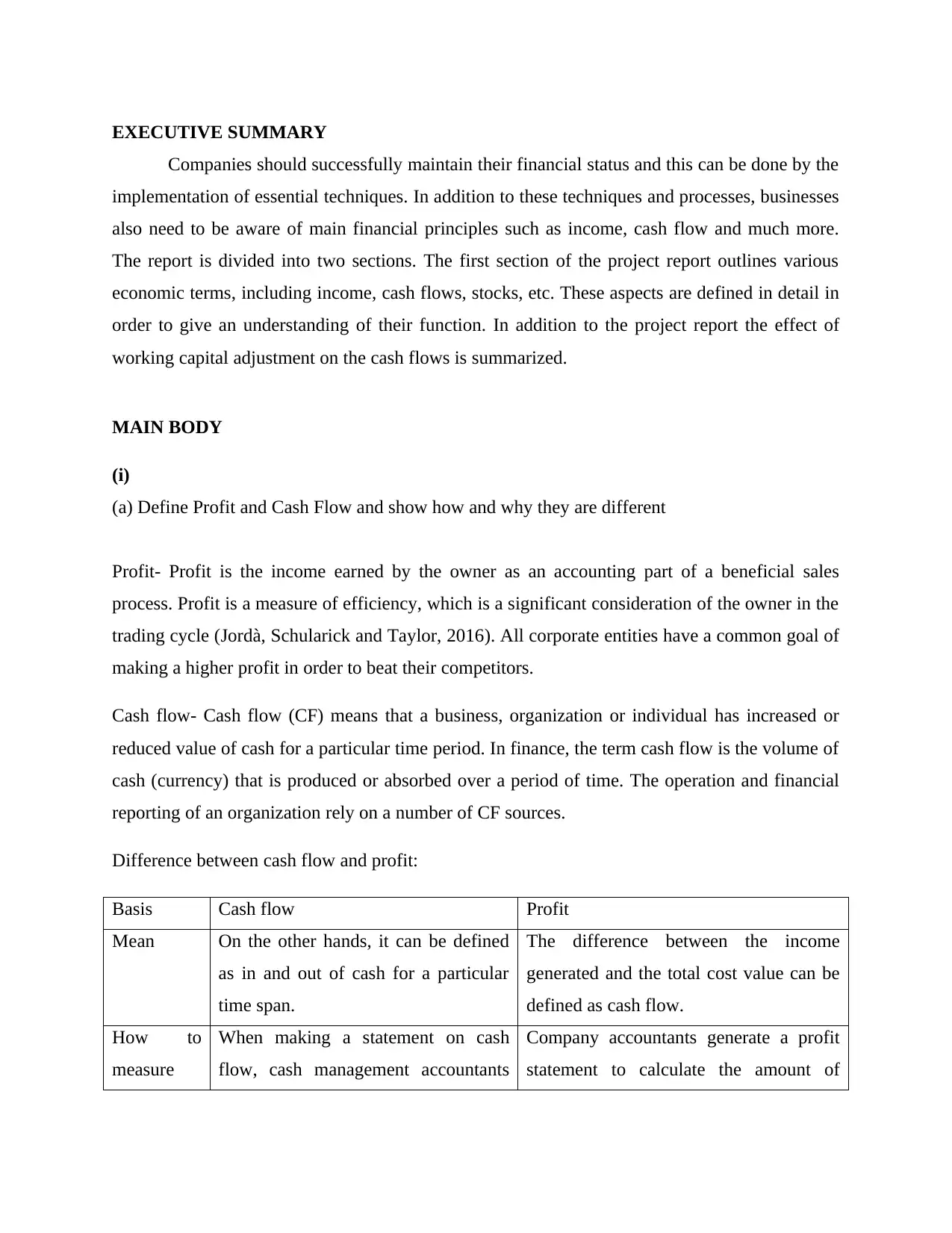
EXECUTIVE SUMMARY
Companies should successfully maintain their financial status and this can be done by the
implementation of essential techniques. In addition to these techniques and processes, businesses
also need to be aware of main financial principles such as income, cash flow and much more.
The report is divided into two sections. The first section of the project report outlines various
economic terms, including income, cash flows, stocks, etc. These aspects are defined in detail in
order to give an understanding of their function. In addition to the project report the effect of
working capital adjustment on the cash flows is summarized.
MAIN BODY
(i)
(a) Define Profit and Cash Flow and show how and why they are different
Profit- Profit is the income earned by the owner as an accounting part of a beneficial sales
process. Profit is a measure of efficiency, which is a significant consideration of the owner in the
trading cycle (Jordà, Schularick and Taylor, 2016). All corporate entities have a common goal of
making a higher profit in order to beat their competitors.
Cash flow- Cash flow (CF) means that a business, organization or individual has increased or
reduced value of cash for a particular time period. In finance, the term cash flow is the volume of
cash (currency) that is produced or absorbed over a period of time. The operation and financial
reporting of an organization rely on a number of CF sources.
Difference between cash flow and profit:
Basis Cash flow Profit
Mean On the other hands, it can be defined
as in and out of cash for a particular
time span.
The difference between the income
generated and the total cost value can be
defined as cash flow.
How to
measure
When making a statement on cash
flow, cash management accountants
Company accountants generate a profit
statement to calculate the amount of
Companies should successfully maintain their financial status and this can be done by the
implementation of essential techniques. In addition to these techniques and processes, businesses
also need to be aware of main financial principles such as income, cash flow and much more.
The report is divided into two sections. The first section of the project report outlines various
economic terms, including income, cash flows, stocks, etc. These aspects are defined in detail in
order to give an understanding of their function. In addition to the project report the effect of
working capital adjustment on the cash flows is summarized.
MAIN BODY
(i)
(a) Define Profit and Cash Flow and show how and why they are different
Profit- Profit is the income earned by the owner as an accounting part of a beneficial sales
process. Profit is a measure of efficiency, which is a significant consideration of the owner in the
trading cycle (Jordà, Schularick and Taylor, 2016). All corporate entities have a common goal of
making a higher profit in order to beat their competitors.
Cash flow- Cash flow (CF) means that a business, organization or individual has increased or
reduced value of cash for a particular time period. In finance, the term cash flow is the volume of
cash (currency) that is produced or absorbed over a period of time. The operation and financial
reporting of an organization rely on a number of CF sources.
Difference between cash flow and profit:
Basis Cash flow Profit
Mean On the other hands, it can be defined
as in and out of cash for a particular
time span.
The difference between the income
generated and the total cost value can be
defined as cash flow.
How to
measure
When making a statement on cash
flow, cash management accountants
Company accountants generate a profit
statement to calculate the amount of
⊘ This is a preview!⊘
Do you want full access?
Subscribe today to unlock all pages.

Trusted by 1+ million students worldwide

are involved in businesses. earnings.
(b) Define Working Capital, Receivables. Payables and Inventory.
Working capital- In general, a difference between the current assets and the company's
current liabilities can be described as working capital. This capital is too valuable for companies
to take important decisions for everyday tasks and operations (Loughran and McDonald, 2016).
Without this capital, businesses can find it difficult to control their daily expenses. Working
capital is an operating liquidity tool accessible to a corporation, entity or some other agency, and
in specific government agencies Working capital, combined with fixed assets such as plants and
equipment, has been considered part of working capital.
Receivables- Account receivables are legitimate credit reports for goods that have not
been paid for but purchased by a corporation and/or the services offered by customers. They are
usually invoices issued by a client and sent to the customer for payment within an appropriate
time. Businesses measure the ratios of accounts receivable so that they can find out the value
they have to pay out to clients and other debtors to administer the receivables.
Payables- The payables are distinct from those in receipt, as if the company has more
payables it says it is responsible for paying more debt. In order that accounts payable can be
reduced to a minimal degree, businesses will be required to pay their payables in a shorter time.
Inventory- Inventories can be defined as the value of any product form stored in factories
for the production of new goods. In general, three types of inventories exist, such as raw
materials, work under way and finished products. The accountants apply a broad variety of
methods to calculate the valuation of the stored goods such as first-in-first out, last in first out
and weighted average.
(c) Effect of fluctuation in working capital on cash flows.
The word working capital is related to current assets and liabilities, as mentioned above.
The cash is a significant factor and the improvements in working capital have a direct effect on
company cash flow (Nyman, 2016). Eventually, accountants measure the increase in working
capital in order to generate cash flow from business operations. Current assets often benefit from
(b) Define Working Capital, Receivables. Payables and Inventory.
Working capital- In general, a difference between the current assets and the company's
current liabilities can be described as working capital. This capital is too valuable for companies
to take important decisions for everyday tasks and operations (Loughran and McDonald, 2016).
Without this capital, businesses can find it difficult to control their daily expenses. Working
capital is an operating liquidity tool accessible to a corporation, entity or some other agency, and
in specific government agencies Working capital, combined with fixed assets such as plants and
equipment, has been considered part of working capital.
Receivables- Account receivables are legitimate credit reports for goods that have not
been paid for but purchased by a corporation and/or the services offered by customers. They are
usually invoices issued by a client and sent to the customer for payment within an appropriate
time. Businesses measure the ratios of accounts receivable so that they can find out the value
they have to pay out to clients and other debtors to administer the receivables.
Payables- The payables are distinct from those in receipt, as if the company has more
payables it says it is responsible for paying more debt. In order that accounts payable can be
reduced to a minimal degree, businesses will be required to pay their payables in a shorter time.
Inventory- Inventories can be defined as the value of any product form stored in factories
for the production of new goods. In general, three types of inventories exist, such as raw
materials, work under way and finished products. The accountants apply a broad variety of
methods to calculate the valuation of the stored goods such as first-in-first out, last in first out
and weighted average.
(c) Effect of fluctuation in working capital on cash flows.
The word working capital is related to current assets and liabilities, as mentioned above.
The cash is a significant factor and the improvements in working capital have a direct effect on
company cash flow (Nyman, 2016). Eventually, accountants measure the increase in working
capital in order to generate cash flow from business operations. Current assets often benefit from
Paraphrase This Document
Need a fresh take? Get an instant paraphrase of this document with our AI Paraphraser
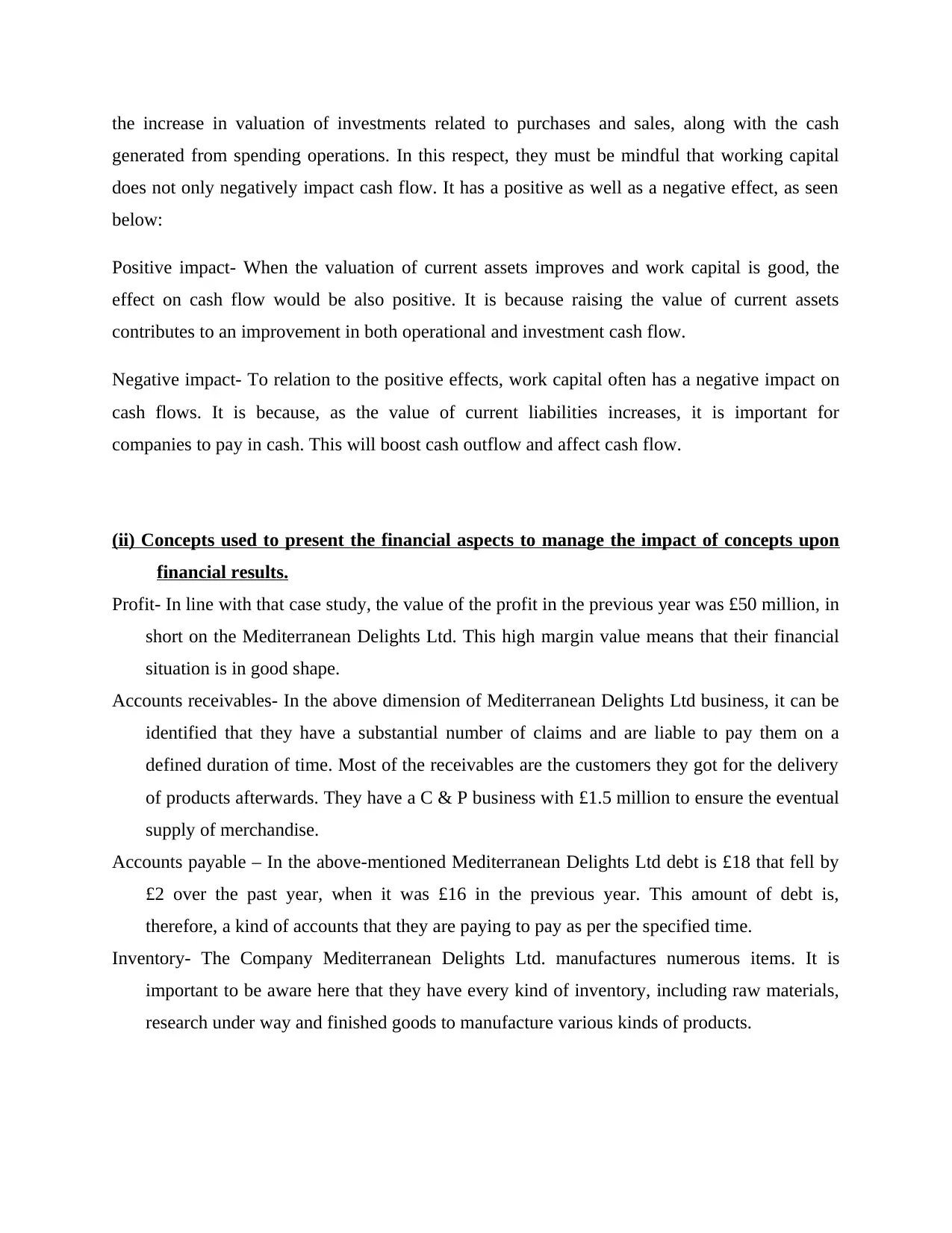
the increase in valuation of investments related to purchases and sales, along with the cash
generated from spending operations. In this respect, they must be mindful that working capital
does not only negatively impact cash flow. It has a positive as well as a negative effect, as seen
below:
Positive impact- When the valuation of current assets improves and work capital is good, the
effect on cash flow would be also positive. It is because raising the value of current assets
contributes to an improvement in both operational and investment cash flow.
Negative impact- To relation to the positive effects, work capital often has a negative impact on
cash flows. It is because, as the value of current liabilities increases, it is important for
companies to pay in cash. This will boost cash outflow and affect cash flow.
(ii) Concepts used to present the financial aspects to manage the impact of concepts upon
financial results.
Profit- In line with that case study, the value of the profit in the previous year was £50 million, in
short on the Mediterranean Delights Ltd. This high margin value means that their financial
situation is in good shape.
Accounts receivables- In the above dimension of Mediterranean Delights Ltd business, it can be
identified that they have a substantial number of claims and are liable to pay them on a
defined duration of time. Most of the receivables are the customers they got for the delivery
of products afterwards. They have a C & P business with £1.5 million to ensure the eventual
supply of merchandise.
Accounts payable – In the above-mentioned Mediterranean Delights Ltd debt is £18 that fell by
£2 over the past year, when it was £16 in the previous year. This amount of debt is,
therefore, a kind of accounts that they are paying to pay as per the specified time.
Inventory- The Company Mediterranean Delights Ltd. manufactures numerous items. It is
important to be aware here that they have every kind of inventory, including raw materials,
research under way and finished goods to manufacture various kinds of products.
generated from spending operations. In this respect, they must be mindful that working capital
does not only negatively impact cash flow. It has a positive as well as a negative effect, as seen
below:
Positive impact- When the valuation of current assets improves and work capital is good, the
effect on cash flow would be also positive. It is because raising the value of current assets
contributes to an improvement in both operational and investment cash flow.
Negative impact- To relation to the positive effects, work capital often has a negative impact on
cash flows. It is because, as the value of current liabilities increases, it is important for
companies to pay in cash. This will boost cash outflow and affect cash flow.
(ii) Concepts used to present the financial aspects to manage the impact of concepts upon
financial results.
Profit- In line with that case study, the value of the profit in the previous year was £50 million, in
short on the Mediterranean Delights Ltd. This high margin value means that their financial
situation is in good shape.
Accounts receivables- In the above dimension of Mediterranean Delights Ltd business, it can be
identified that they have a substantial number of claims and are liable to pay them on a
defined duration of time. Most of the receivables are the customers they got for the delivery
of products afterwards. They have a C & P business with £1.5 million to ensure the eventual
supply of merchandise.
Accounts payable – In the above-mentioned Mediterranean Delights Ltd debt is £18 that fell by
£2 over the past year, when it was £16 in the previous year. This amount of debt is,
therefore, a kind of accounts that they are paying to pay as per the specified time.
Inventory- The Company Mediterranean Delights Ltd. manufactures numerous items. It is
important to be aware here that they have every kind of inventory, including raw materials,
research under way and finished goods to manufacture various kinds of products.
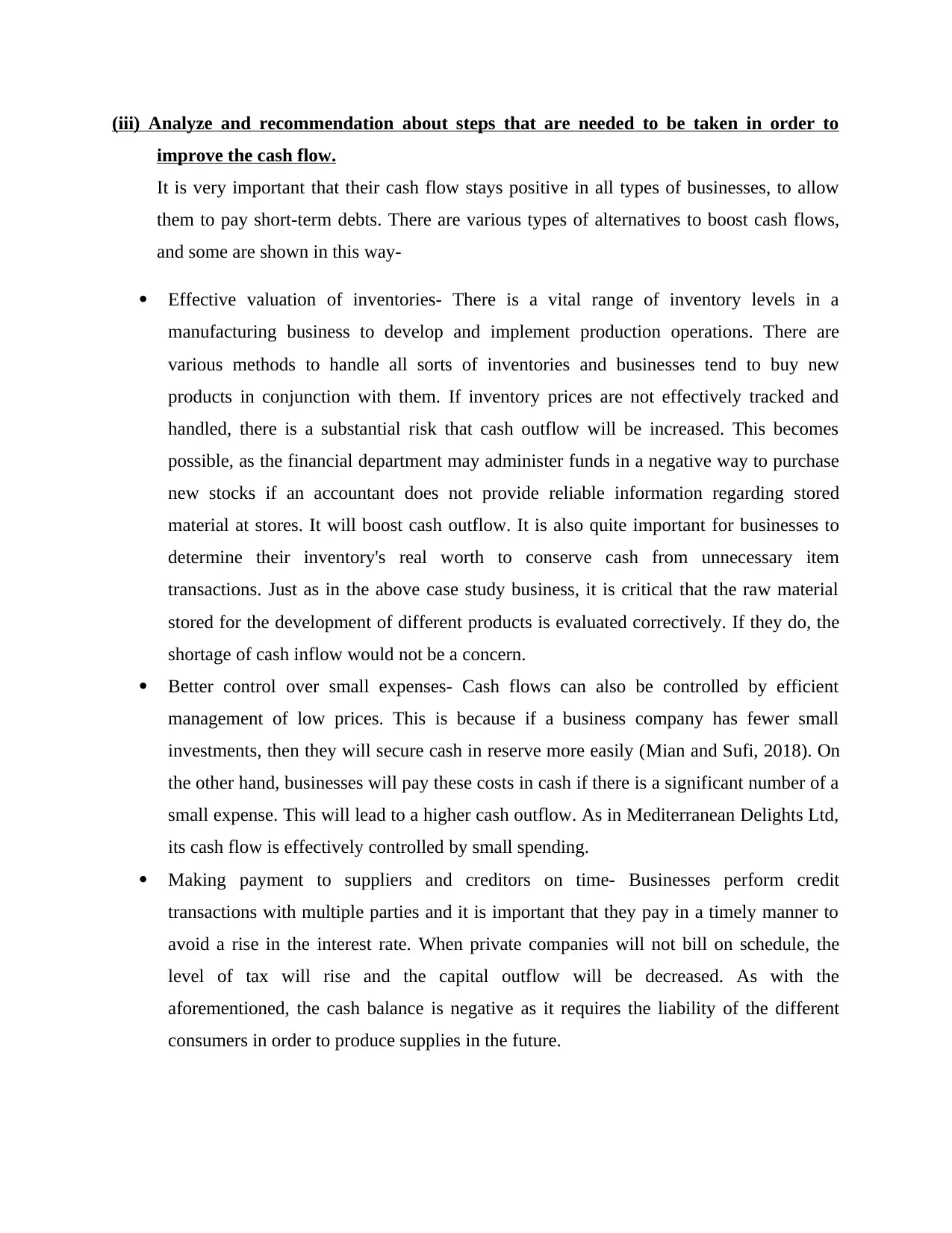
(iii) Analyze and recommendation about steps that are needed to be taken in order to
improve the cash flow.
It is very important that their cash flow stays positive in all types of businesses, to allow
them to pay short-term debts. There are various types of alternatives to boost cash flows,
and some are shown in this way-
Effective valuation of inventories- There is a vital range of inventory levels in a
manufacturing business to develop and implement production operations. There are
various methods to handle all sorts of inventories and businesses tend to buy new
products in conjunction with them. If inventory prices are not effectively tracked and
handled, there is a substantial risk that cash outflow will be increased. This becomes
possible, as the financial department may administer funds in a negative way to purchase
new stocks if an accountant does not provide reliable information regarding stored
material at stores. It will boost cash outflow. It is also quite important for businesses to
determine their inventory's real worth to conserve cash from unnecessary item
transactions. Just as in the above case study business, it is critical that the raw material
stored for the development of different products is evaluated correctively. If they do, the
shortage of cash inflow would not be a concern.
Better control over small expenses- Cash flows can also be controlled by efficient
management of low prices. This is because if a business company has fewer small
investments, then they will secure cash in reserve more easily (Mian and Sufi, 2018). On
the other hand, businesses will pay these costs in cash if there is a significant number of a
small expense. This will lead to a higher cash outflow. As in Mediterranean Delights Ltd,
its cash flow is effectively controlled by small spending.
Making payment to suppliers and creditors on time- Businesses perform credit
transactions with multiple parties and it is important that they pay in a timely manner to
avoid a rise in the interest rate. When private companies will not bill on schedule, the
level of tax will rise and the capital outflow will be decreased. As with the
aforementioned, the cash balance is negative as it requires the liability of the different
consumers in order to produce supplies in the future.
improve the cash flow.
It is very important that their cash flow stays positive in all types of businesses, to allow
them to pay short-term debts. There are various types of alternatives to boost cash flows,
and some are shown in this way-
Effective valuation of inventories- There is a vital range of inventory levels in a
manufacturing business to develop and implement production operations. There are
various methods to handle all sorts of inventories and businesses tend to buy new
products in conjunction with them. If inventory prices are not effectively tracked and
handled, there is a substantial risk that cash outflow will be increased. This becomes
possible, as the financial department may administer funds in a negative way to purchase
new stocks if an accountant does not provide reliable information regarding stored
material at stores. It will boost cash outflow. It is also quite important for businesses to
determine their inventory's real worth to conserve cash from unnecessary item
transactions. Just as in the above case study business, it is critical that the raw material
stored for the development of different products is evaluated correctively. If they do, the
shortage of cash inflow would not be a concern.
Better control over small expenses- Cash flows can also be controlled by efficient
management of low prices. This is because if a business company has fewer small
investments, then they will secure cash in reserve more easily (Mian and Sufi, 2018). On
the other hand, businesses will pay these costs in cash if there is a significant number of a
small expense. This will lead to a higher cash outflow. As in Mediterranean Delights Ltd,
its cash flow is effectively controlled by small spending.
Making payment to suppliers and creditors on time- Businesses perform credit
transactions with multiple parties and it is important that they pay in a timely manner to
avoid a rise in the interest rate. When private companies will not bill on schedule, the
level of tax will rise and the capital outflow will be decreased. As with the
aforementioned, the cash balance is negative as it requires the liability of the different
consumers in order to produce supplies in the future.
⊘ This is a preview!⊘
Do you want full access?
Subscribe today to unlock all pages.

Trusted by 1+ million students worldwide
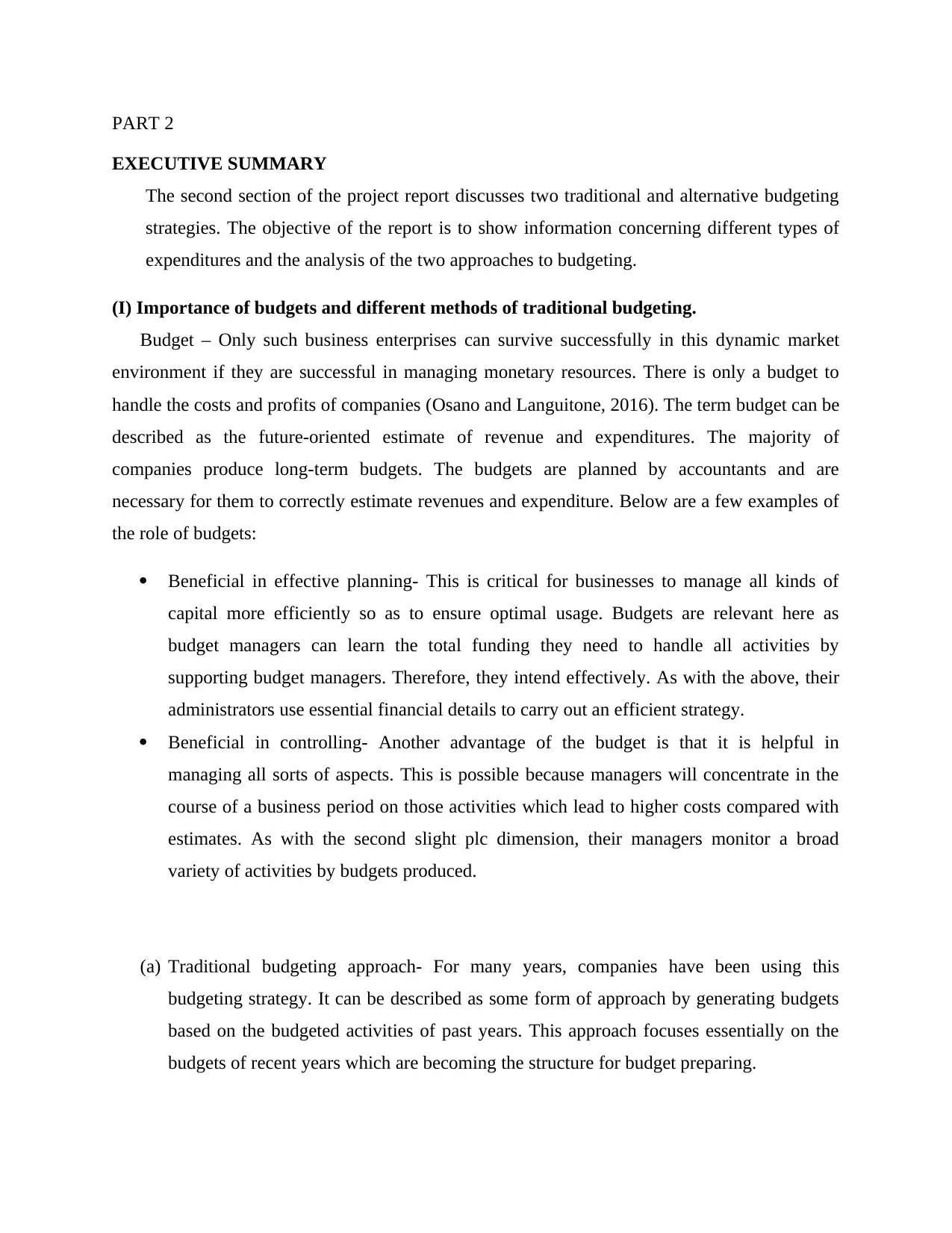
PART 2
EXECUTIVE SUMMARY
The second section of the project report discusses two traditional and alternative budgeting
strategies. The objective of the report is to show information concerning different types of
expenditures and the analysis of the two approaches to budgeting.
(I) Importance of budgets and different methods of traditional budgeting.
Budget – Only such business enterprises can survive successfully in this dynamic market
environment if they are successful in managing monetary resources. There is only a budget to
handle the costs and profits of companies (Osano and Languitone, 2016). The term budget can be
described as the future-oriented estimate of revenue and expenditures. The majority of
companies produce long-term budgets. The budgets are planned by accountants and are
necessary for them to correctly estimate revenues and expenditure. Below are a few examples of
the role of budgets:
Beneficial in effective planning- This is critical for businesses to manage all kinds of
capital more efficiently so as to ensure optimal usage. Budgets are relevant here as
budget managers can learn the total funding they need to handle all activities by
supporting budget managers. Therefore, they intend effectively. As with the above, their
administrators use essential financial details to carry out an efficient strategy.
Beneficial in controlling- Another advantage of the budget is that it is helpful in
managing all sorts of aspects. This is possible because managers will concentrate in the
course of a business period on those activities which lead to higher costs compared with
estimates. As with the second slight plc dimension, their managers monitor a broad
variety of activities by budgets produced.
(a) Traditional budgeting approach- For many years, companies have been using this
budgeting strategy. It can be described as some form of approach by generating budgets
based on the budgeted activities of past years. This approach focuses essentially on the
budgets of recent years which are becoming the structure for budget preparing.
EXECUTIVE SUMMARY
The second section of the project report discusses two traditional and alternative budgeting
strategies. The objective of the report is to show information concerning different types of
expenditures and the analysis of the two approaches to budgeting.
(I) Importance of budgets and different methods of traditional budgeting.
Budget – Only such business enterprises can survive successfully in this dynamic market
environment if they are successful in managing monetary resources. There is only a budget to
handle the costs and profits of companies (Osano and Languitone, 2016). The term budget can be
described as the future-oriented estimate of revenue and expenditures. The majority of
companies produce long-term budgets. The budgets are planned by accountants and are
necessary for them to correctly estimate revenues and expenditure. Below are a few examples of
the role of budgets:
Beneficial in effective planning- This is critical for businesses to manage all kinds of
capital more efficiently so as to ensure optimal usage. Budgets are relevant here as
budget managers can learn the total funding they need to handle all activities by
supporting budget managers. Therefore, they intend effectively. As with the above, their
administrators use essential financial details to carry out an efficient strategy.
Beneficial in controlling- Another advantage of the budget is that it is helpful in
managing all sorts of aspects. This is possible because managers will concentrate in the
course of a business period on those activities which lead to higher costs compared with
estimates. As with the second slight plc dimension, their managers monitor a broad
variety of activities by budgets produced.
(a) Traditional budgeting approach- For many years, companies have been using this
budgeting strategy. It can be described as some form of approach by generating budgets
based on the budgeted activities of past years. This approach focuses essentially on the
budgets of recent years which are becoming the structure for budget preparing.
Paraphrase This Document
Need a fresh take? Get an instant paraphrase of this document with our AI Paraphraser
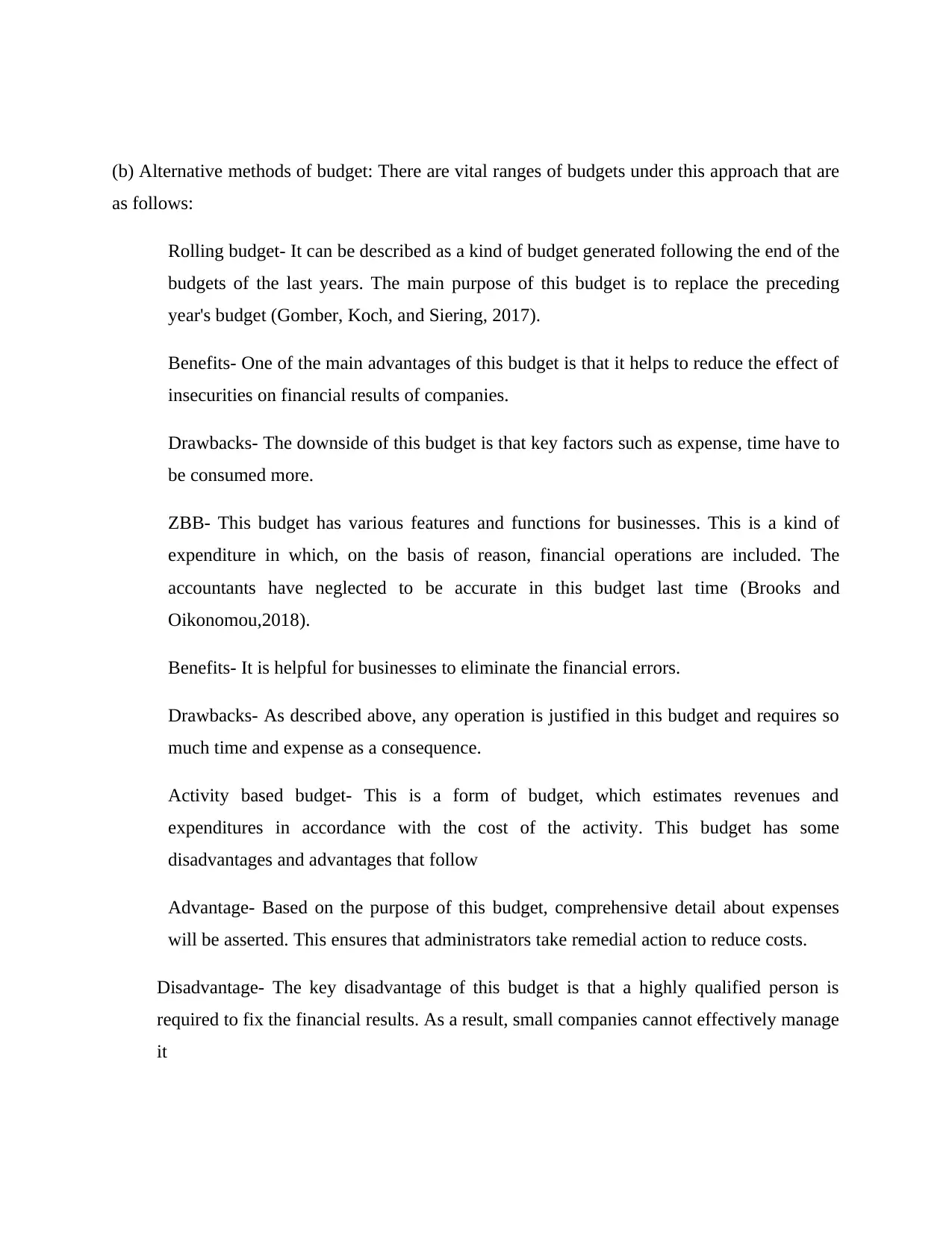
(b) Alternative methods of budget: There are vital ranges of budgets under this approach that are
as follows:
Rolling budget- It can be described as a kind of budget generated following the end of the
budgets of the last years. The main purpose of this budget is to replace the preceding
year's budget (Gomber, Koch, and Siering, 2017).
Benefits- One of the main advantages of this budget is that it helps to reduce the effect of
insecurities on financial results of companies.
Drawbacks- The downside of this budget is that key factors such as expense, time have to
be consumed more.
ZBB- This budget has various features and functions for businesses. This is a kind of
expenditure in which, on the basis of reason, financial operations are included. The
accountants have neglected to be accurate in this budget last time (Brooks and
Oikonomou,2018).
Benefits- It is helpful for businesses to eliminate the financial errors.
Drawbacks- As described above, any operation is justified in this budget and requires so
much time and expense as a consequence.
Activity based budget- This is a form of budget, which estimates revenues and
expenditures in accordance with the cost of the activity. This budget has some
disadvantages and advantages that follow
Advantage- Based on the purpose of this budget, comprehensive detail about expenses
will be asserted. This ensures that administrators take remedial action to reduce costs.
Disadvantage- The key disadvantage of this budget is that a highly qualified person is
required to fix the financial results. As a result, small companies cannot effectively manage
it
as follows:
Rolling budget- It can be described as a kind of budget generated following the end of the
budgets of the last years. The main purpose of this budget is to replace the preceding
year's budget (Gomber, Koch, and Siering, 2017).
Benefits- One of the main advantages of this budget is that it helps to reduce the effect of
insecurities on financial results of companies.
Drawbacks- The downside of this budget is that key factors such as expense, time have to
be consumed more.
ZBB- This budget has various features and functions for businesses. This is a kind of
expenditure in which, on the basis of reason, financial operations are included. The
accountants have neglected to be accurate in this budget last time (Brooks and
Oikonomou,2018).
Benefits- It is helpful for businesses to eliminate the financial errors.
Drawbacks- As described above, any operation is justified in this budget and requires so
much time and expense as a consequence.
Activity based budget- This is a form of budget, which estimates revenues and
expenditures in accordance with the cost of the activity. This budget has some
disadvantages and advantages that follow
Advantage- Based on the purpose of this budget, comprehensive detail about expenses
will be asserted. This ensures that administrators take remedial action to reduce costs.
Disadvantage- The key disadvantage of this budget is that a highly qualified person is
required to fix the financial results. As a result, small companies cannot effectively manage
it
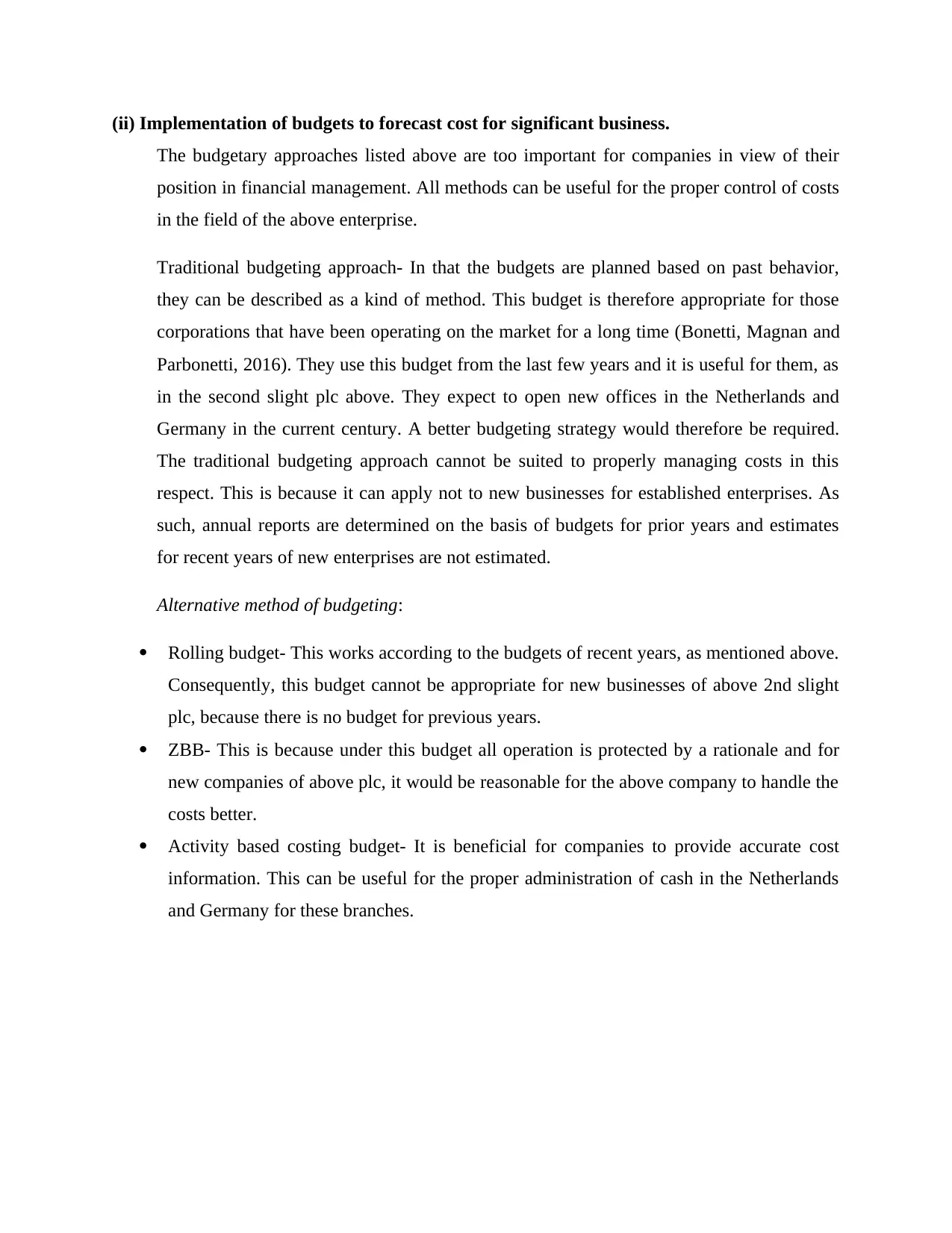
(ii) Implementation of budgets to forecast cost for significant business.
The budgetary approaches listed above are too important for companies in view of their
position in financial management. All methods can be useful for the proper control of costs
in the field of the above enterprise.
Traditional budgeting approach- In that the budgets are planned based on past behavior,
they can be described as a kind of method. This budget is therefore appropriate for those
corporations that have been operating on the market for a long time (Bonetti, Magnan and
Parbonetti, 2016). They use this budget from the last few years and it is useful for them, as
in the second slight plc above. They expect to open new offices in the Netherlands and
Germany in the current century. A better budgeting strategy would therefore be required.
The traditional budgeting approach cannot be suited to properly managing costs in this
respect. This is because it can apply not to new businesses for established enterprises. As
such, annual reports are determined on the basis of budgets for prior years and estimates
for recent years of new enterprises are not estimated.
Alternative method of budgeting:
Rolling budget- This works according to the budgets of recent years, as mentioned above.
Consequently, this budget cannot be appropriate for new businesses of above 2nd slight
plc, because there is no budget for previous years.
ZBB- This is because under this budget all operation is protected by a rationale and for
new companies of above plc, it would be reasonable for the above company to handle the
costs better.
Activity based costing budget- It is beneficial for companies to provide accurate cost
information. This can be useful for the proper administration of cash in the Netherlands
and Germany for these branches.
The budgetary approaches listed above are too important for companies in view of their
position in financial management. All methods can be useful for the proper control of costs
in the field of the above enterprise.
Traditional budgeting approach- In that the budgets are planned based on past behavior,
they can be described as a kind of method. This budget is therefore appropriate for those
corporations that have been operating on the market for a long time (Bonetti, Magnan and
Parbonetti, 2016). They use this budget from the last few years and it is useful for them, as
in the second slight plc above. They expect to open new offices in the Netherlands and
Germany in the current century. A better budgeting strategy would therefore be required.
The traditional budgeting approach cannot be suited to properly managing costs in this
respect. This is because it can apply not to new businesses for established enterprises. As
such, annual reports are determined on the basis of budgets for prior years and estimates
for recent years of new enterprises are not estimated.
Alternative method of budgeting:
Rolling budget- This works according to the budgets of recent years, as mentioned above.
Consequently, this budget cannot be appropriate for new businesses of above 2nd slight
plc, because there is no budget for previous years.
ZBB- This is because under this budget all operation is protected by a rationale and for
new companies of above plc, it would be reasonable for the above company to handle the
costs better.
Activity based costing budget- It is beneficial for companies to provide accurate cost
information. This can be useful for the proper administration of cash in the Netherlands
and Germany for these branches.
⊘ This is a preview!⊘
Do you want full access?
Subscribe today to unlock all pages.

Trusted by 1+ million students worldwide
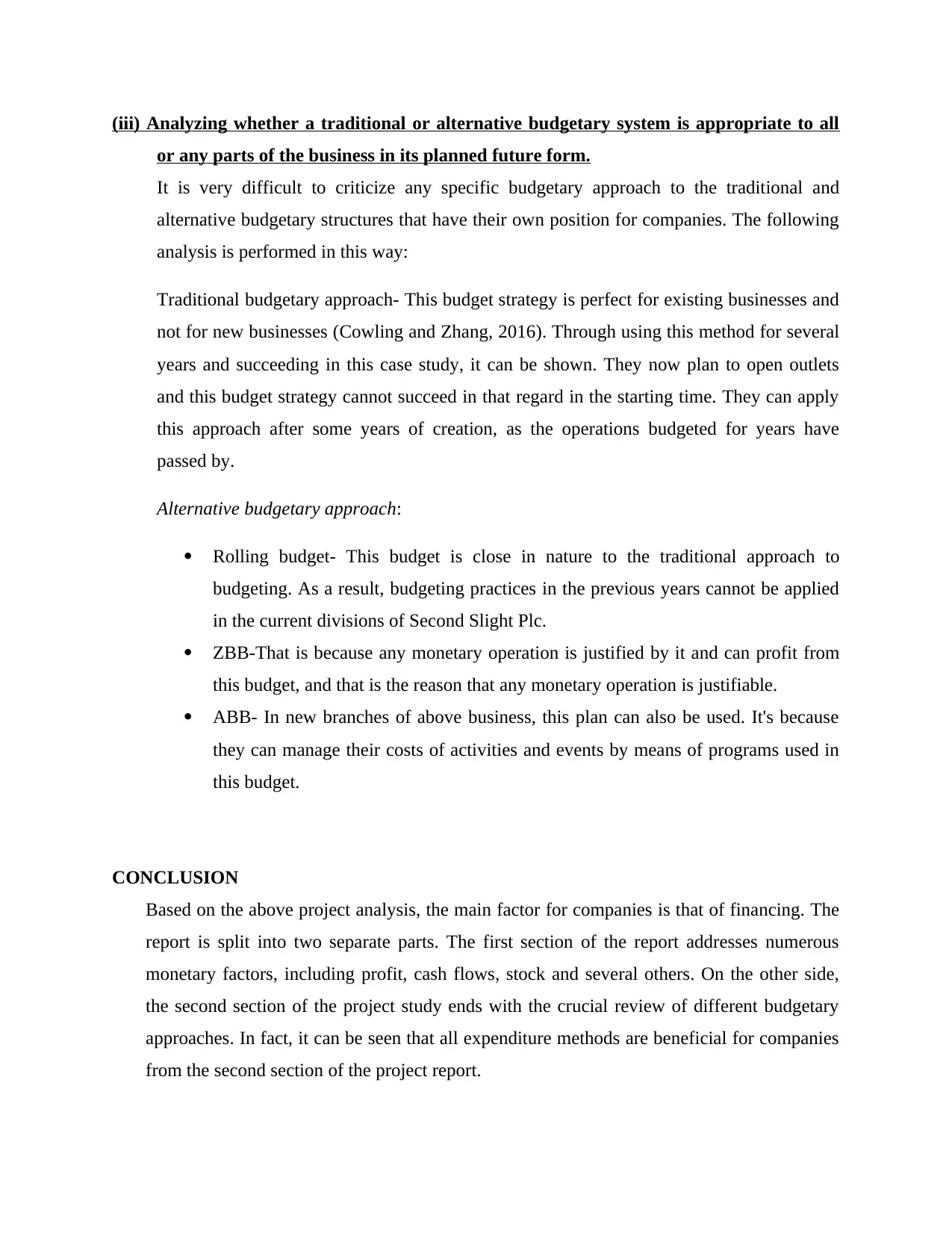
(iii) Analyzing whether a traditional or alternative budgetary system is appropriate to all
or any parts of the business in its planned future form.
It is very difficult to criticize any specific budgetary approach to the traditional and
alternative budgetary structures that have their own position for companies. The following
analysis is performed in this way:
Traditional budgetary approach- This budget strategy is perfect for existing businesses and
not for new businesses (Cowling and Zhang, 2016). Through using this method for several
years and succeeding in this case study, it can be shown. They now plan to open outlets
and this budget strategy cannot succeed in that regard in the starting time. They can apply
this approach after some years of creation, as the operations budgeted for years have
passed by.
Alternative budgetary approach:
Rolling budget- This budget is close in nature to the traditional approach to
budgeting. As a result, budgeting practices in the previous years cannot be applied
in the current divisions of Second Slight Plc.
ZBB-That is because any monetary operation is justified by it and can profit from
this budget, and that is the reason that any monetary operation is justifiable.
ABB- In new branches of above business, this plan can also be used. It's because
they can manage their costs of activities and events by means of programs used in
this budget.
CONCLUSION
Based on the above project analysis, the main factor for companies is that of financing. The
report is split into two separate parts. The first section of the report addresses numerous
monetary factors, including profit, cash flows, stock and several others. On the other side,
the second section of the project study ends with the crucial review of different budgetary
approaches. In fact, it can be seen that all expenditure methods are beneficial for companies
from the second section of the project report.
or any parts of the business in its planned future form.
It is very difficult to criticize any specific budgetary approach to the traditional and
alternative budgetary structures that have their own position for companies. The following
analysis is performed in this way:
Traditional budgetary approach- This budget strategy is perfect for existing businesses and
not for new businesses (Cowling and Zhang, 2016). Through using this method for several
years and succeeding in this case study, it can be shown. They now plan to open outlets
and this budget strategy cannot succeed in that regard in the starting time. They can apply
this approach after some years of creation, as the operations budgeted for years have
passed by.
Alternative budgetary approach:
Rolling budget- This budget is close in nature to the traditional approach to
budgeting. As a result, budgeting practices in the previous years cannot be applied
in the current divisions of Second Slight Plc.
ZBB-That is because any monetary operation is justified by it and can profit from
this budget, and that is the reason that any monetary operation is justifiable.
ABB- In new branches of above business, this plan can also be used. It's because
they can manage their costs of activities and events by means of programs used in
this budget.
CONCLUSION
Based on the above project analysis, the main factor for companies is that of financing. The
report is split into two separate parts. The first section of the report addresses numerous
monetary factors, including profit, cash flows, stock and several others. On the other side,
the second section of the project study ends with the crucial review of different budgetary
approaches. In fact, it can be seen that all expenditure methods are beneficial for companies
from the second section of the project report.
Paraphrase This Document
Need a fresh take? Get an instant paraphrase of this document with our AI Paraphraser

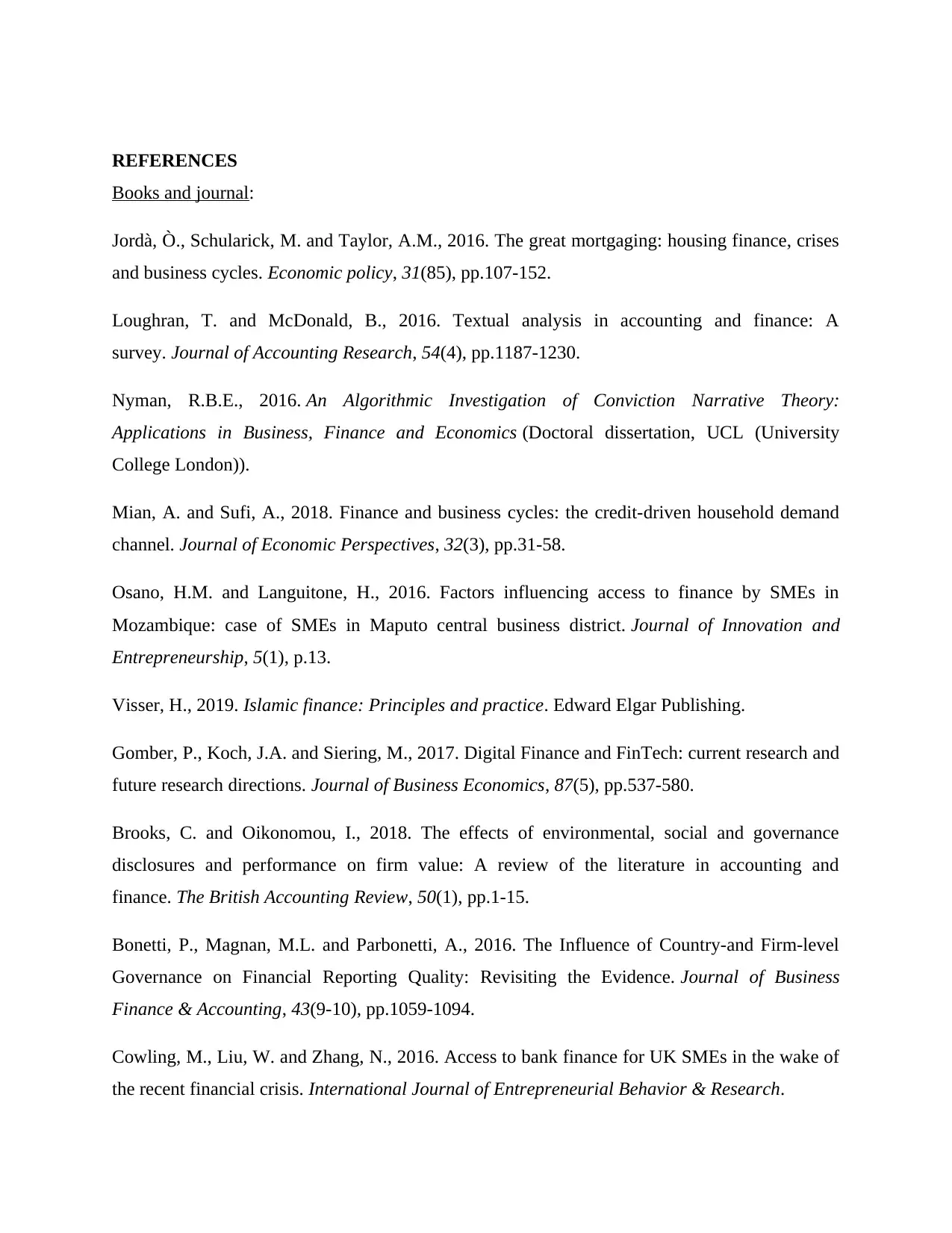
REFERENCES
Books and journal:
Jordà, Ò., Schularick, M. and Taylor, A.M., 2016. The great mortgaging: housing finance, crises
and business cycles. Economic policy, 31(85), pp.107-152.
Loughran, T. and McDonald, B., 2016. Textual analysis in accounting and finance: A
survey. Journal of Accounting Research, 54(4), pp.1187-1230.
Nyman, R.B.E., 2016. An Algorithmic Investigation of Conviction Narrative Theory:
Applications in Business, Finance and Economics (Doctoral dissertation, UCL (University
College London)).
Mian, A. and Sufi, A., 2018. Finance and business cycles: the credit-driven household demand
channel. Journal of Economic Perspectives, 32(3), pp.31-58.
Osano, H.M. and Languitone, H., 2016. Factors influencing access to finance by SMEs in
Mozambique: case of SMEs in Maputo central business district. Journal of Innovation and
Entrepreneurship, 5(1), p.13.
Visser, H., 2019. Islamic finance: Principles and practice. Edward Elgar Publishing.
Gomber, P., Koch, J.A. and Siering, M., 2017. Digital Finance and FinTech: current research and
future research directions. Journal of Business Economics, 87(5), pp.537-580.
Brooks, C. and Oikonomou, I., 2018. The effects of environmental, social and governance
disclosures and performance on firm value: A review of the literature in accounting and
finance. The British Accounting Review, 50(1), pp.1-15.
Bonetti, P., Magnan, M.L. and Parbonetti, A., 2016. The Influence of Country‐and Firm‐level
Governance on Financial Reporting Quality: Revisiting the Evidence. Journal of Business
Finance & Accounting, 43(9-10), pp.1059-1094.
Cowling, M., Liu, W. and Zhang, N., 2016. Access to bank finance for UK SMEs in the wake of
the recent financial crisis. International Journal of Entrepreneurial Behavior & Research.
Books and journal:
Jordà, Ò., Schularick, M. and Taylor, A.M., 2016. The great mortgaging: housing finance, crises
and business cycles. Economic policy, 31(85), pp.107-152.
Loughran, T. and McDonald, B., 2016. Textual analysis in accounting and finance: A
survey. Journal of Accounting Research, 54(4), pp.1187-1230.
Nyman, R.B.E., 2016. An Algorithmic Investigation of Conviction Narrative Theory:
Applications in Business, Finance and Economics (Doctoral dissertation, UCL (University
College London)).
Mian, A. and Sufi, A., 2018. Finance and business cycles: the credit-driven household demand
channel. Journal of Economic Perspectives, 32(3), pp.31-58.
Osano, H.M. and Languitone, H., 2016. Factors influencing access to finance by SMEs in
Mozambique: case of SMEs in Maputo central business district. Journal of Innovation and
Entrepreneurship, 5(1), p.13.
Visser, H., 2019. Islamic finance: Principles and practice. Edward Elgar Publishing.
Gomber, P., Koch, J.A. and Siering, M., 2017. Digital Finance and FinTech: current research and
future research directions. Journal of Business Economics, 87(5), pp.537-580.
Brooks, C. and Oikonomou, I., 2018. The effects of environmental, social and governance
disclosures and performance on firm value: A review of the literature in accounting and
finance. The British Accounting Review, 50(1), pp.1-15.
Bonetti, P., Magnan, M.L. and Parbonetti, A., 2016. The Influence of Country‐and Firm‐level
Governance on Financial Reporting Quality: Revisiting the Evidence. Journal of Business
Finance & Accounting, 43(9-10), pp.1059-1094.
Cowling, M., Liu, W. and Zhang, N., 2016. Access to bank finance for UK SMEs in the wake of
the recent financial crisis. International Journal of Entrepreneurial Behavior & Research.
⊘ This is a preview!⊘
Do you want full access?
Subscribe today to unlock all pages.

Trusted by 1+ million students worldwide
1 out of 13
Related Documents
Your All-in-One AI-Powered Toolkit for Academic Success.
+13062052269
info@desklib.com
Available 24*7 on WhatsApp / Email
![[object Object]](/_next/static/media/star-bottom.7253800d.svg)
Unlock your academic potential
Copyright © 2020–2025 A2Z Services. All Rights Reserved. Developed and managed by ZUCOL.





